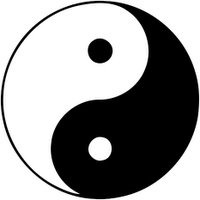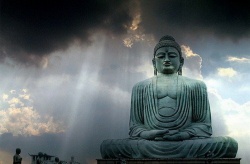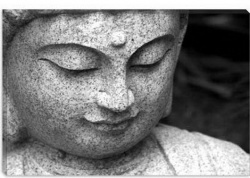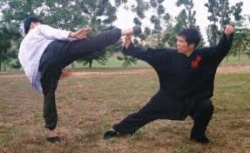Yin and yang
In Chinese philosophy, the concept of yin-yang (simplified Chinese: 阴阳; traditional Chinese: 陰陽; pinyin: yīnyáng), which is often called "yin and yang", is used to describe how opposite or contrary forces are interconnected and interdependent in the natural world; and, how they give rise to each other as they interrelate to one another. Many natural dualities (such as light and dark, high and low, hot and cold, fire and water, life and death, and so on) are thought of as physical manifestations of the yin-yang concept. The concept lies at the origins of many branches of classical Chinese science and philosophy, as well as being a primary guideline of traditional Chinese medicine, and a central principle of different forms of Chinese martial arts and exercise, such as baguazhang, taijiquan (t'ai chi), qigong (Chi Kung), and I Ching.
Yin and yang can be thought of as complementary (instead of opposing) forces interacting to form a dynamic system in which the whole is greater than the parts. Everything has both yin and yang aspects, (for instance shadow cannot exist without light). Either of the two major aspects may manifest more strongly in a particular object, depending on the criterion of the observation.
In Taoist metaphysics, good-bad distinctions and other dichotomous moral judgments are perceptual, not real; so, yin-yang is an indivisible whole. In the ethics of Confucianism on the other hand, most notably in the philosophy of Dong Zhongshu, (c. 2nd century BC) a moral dimension is attached to the yin-yang idea.
The concept of yin and yang is often symbolized by various forms of the Taijitu symbol, for which it is probably best known in Western cultures.
Nature
In Daoist philosophy, dark and light, yin and yang, arrive in the Dàodéjīng (道德經) at chapter 42. It becomes sensible from an initial quiescence or emptiness (wuji, sometimes symbolized by an empty circle), and continues moving until quiescence is reached again. For instance, dropping a stone in a calm pool of water will simultaneously raise waves and lower troughs between them, and this alternation of high and low points in the water will radiate outward until the movement dissipates and the pool is calm once more. Yin and yang thus are always opposite and equal qualities. Further, whenever one quality reaches its peak, it will naturally begin to transform into the opposite quality: for example, grain that reaches its full height in summer (fully yang) will produce seeds and die back in winter (fully yin) in an endless cycle.
It is impossible to talk about yin or yang without some reference to the opposite, since yin and yang are bound together as parts of a mutual whole (for example, there cannot be the bottom of the foot without the top). A way to illustrate this idea is to postulate the notion of a race with only men or only women; this race would disappear in a single generation. Yet, men and women together create new generations that allow the race they mutually create (and mutually come from) to survive. The interaction of the two gives birth to things. Yin and yang transform each other: like an undertow in the ocean, every advance is complemented by a retreat, and every rise transforms into a fall. Thus, a seed will sprout from the earth and grow upwards towards the sky—an intrinsically yang movement. Then, when it reaches its full potential height, it will fall. Also, the growth of the top seeks light, while roots grow in darkness.
Toponymy
Many places in China, such as Luoyang, contain the word yang, and a few, such as Huayin, contain the word yin. This is a very old way to assign place names.
Classically, when used in place names, yang refers to the "sunny side." The word 太陽 (simplified 太阳), tàiyáng, refers to the sun, and literally means "great yang." In the northern hemisphere, sunlight comes predominantly from the south, and so the south face of a mountain (or the north face of a river valley) will get more direct sunlight. Therefore, yang means a place is on the south slope of a mountain (or on the north bank of a river valley). For example, Luoyang is on the north bank of the Luo River valley.
In the same way, yin would be the opposite, the "shady side." Yin means that a place is on the north slope of a mountain (or on the south bank of a river). For example, Huayin is on the north slope of Mount Hua.
Symbolism and importance
Yin is the black side with the white dot on it, and yang is the white side with the black dot on it. The relationship between yin and yang is often described in terms of sunlight playing over a mountain and a valley. Yin (literally the 'shady place' or 'north slope') is the dark area occluded by the mountain's bulk, while yang (literally the 'sunny place' or 'south slope') is the brightly lit portion. As the sun moves across the sky, yin and yang gradually trade places with each other, revealing what was obscured and obscuring what was revealed.
Yin is characterized as slow, soft, yielding, diffuse, cold, wet, and passive; and is associated with water, earth, the moon, femininity and nighttime.
Yang, by contrast, is fast, hard, solid, focused, hot, dry, and aggressive; and is associated with fire, sky, the sun, masculinity and daytime.
Yin and yang applies to the human body. In traditional Chinese medicine good health is directly related to the balance between yin and yang qualities within oneself. If yin and yang become unbalanced, one of the qualities is considered deficient or has vacuity.
I Ching
In the I Ching, yin and yang are represented by broken and solid lines: yin is broken (⚋) and yang is solid (⚊). These are then combined into trigrams, which are more yang or more yin depending on the number of broken and solid lines (e.g., ☰ is heavily yang, while ☷ is heavily yin), and trigrams are combined into hexagrams (e.g. ䷕ and ䷟). The relative positions and numbers of yin and yang lines within the trigrams determines the meaning of a trigram, and in hexagrams the upper trigram is considered yang with respect to the lower trigram, allowing complex depictions of interrelations.
Taijitu
The principle of yin and yang is represented in Taoism by the Taijitu (literally "diagram of the supreme ultimate"). The term is commonly used to mean the simple "divided circle" form, but may refer to any of several schematic diagrams representing these principles, such as the swastika, common to Hinduism, Buddhism, and Jainism. Similar symbols have also appeared in other cultures, such as in Celtic art and Roman shield markings.
Taijiquan
Taijiquan, a form of martial art, is often described as the principles of yin and yang applied to the human body and an animal body. Wu Jianquan, a famous Chinese martial arts teacher, described Taijiquan as follows:
- Various people have offered different explanations for the name Taijiquan. Some have said: – 'In terms of self-cultivation, one must train from a state of movement towards a state of stillness. Taiji comes about through the balance of yin and yang. In terms of the art of attack and defense then, in the context of the changes of full and empty, one is constantly internally latent, not outwardly expressive, as if the yin and yang of Taiji have not yet divided apart.' Others say: 'Every movement of Taijiquan is based on circles, just like the shape of a Taijitu. Therefore, it is called Taijiquan.




